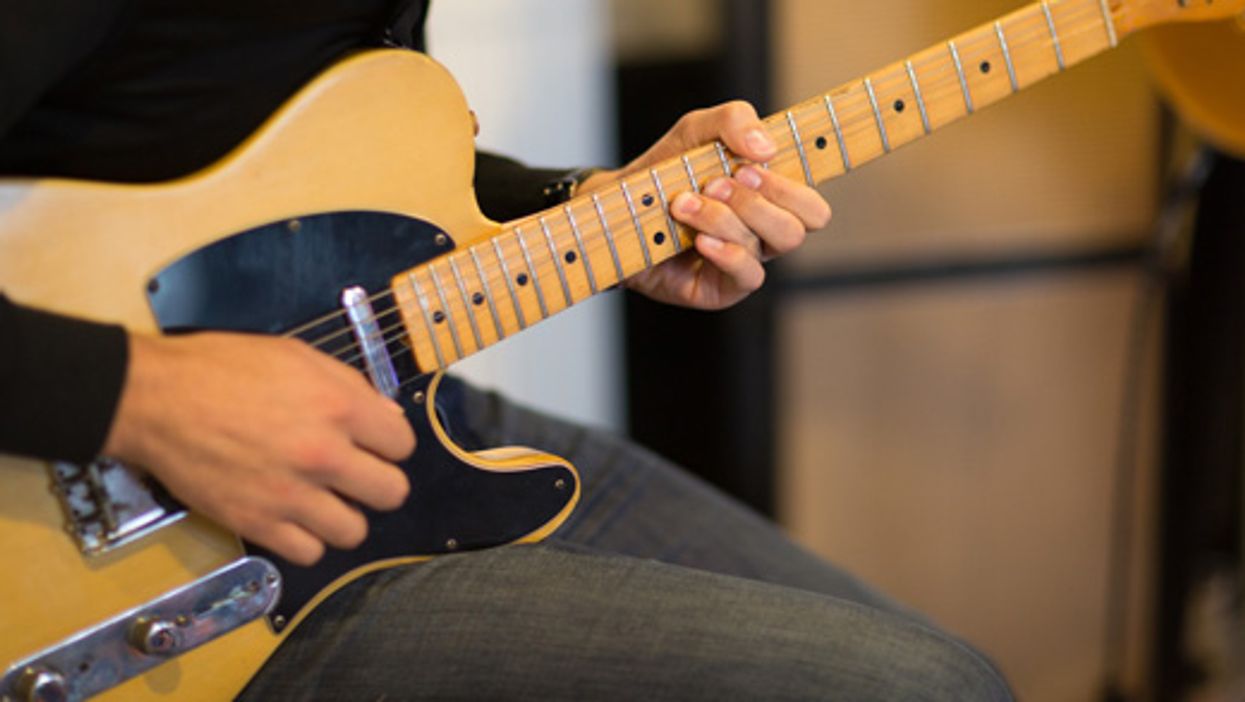Chops: Intermediate
Theory: Beginner
Lesson Overview:
• Learn how to use hybrid picking to play cross-string scales.
• Discover how to combine different picking patterns into a single phrase.
• Explore West African melodic ornamentation.
Click here to download a printable PDF of this lesson's notation.
For this month’s global music tour, we’ll venture into areas of West Africa that are brimming with great music—both traditional and modern. There are many fantastic guitarists there, including Djelimady Tounkara from Mali, who is one of my absolute faves. However, for this lesson we’ll delve into imitating the styles of other instruments on guitar, specifically a 21-string African harp called the kora. To keep things shredtastic, we’ll explore the techniques of hybrid picking using cross-string scales.
The kora has two sides or rows of harp strings that are attached to a large resonating gourd or calabash. Because the kora is ancient, and songs have been taught and passed down for hundreds of generations, it’s played with an astounding technique. The double harp rows are often used to play fast, resonating lines and scales. Alternatively, one hand can play a repeating ostinato pattern (called “kumbengo”), while the other executes a melody. One of my favorite kora players—and the inspiration for this lesson—is Toumane Diabaté. Check out the video below to see a basic primer straight from Diabaté:
Much of the real beauty of the kora lies in letting the notes ring out. Diabaté is a master of this shimmering sound, though he also does intricate muting when the music demands it. To emulate the kora on guitar, it’s important to play cross-string scales: Instead of fretting consecutive notes on the same string, we’ll find ways to attack each note on a different string—a technique that allows notes to sustain and blend together. Do to the tuning of the guitar, this can lead to some tricky left-hand stretches, but with some practice the results are beautiful. The key here is to use hybrid picking. With this technique, you grip the flatpick as normal with your thumb and index finger, but also use your middle and ring fingers (notated in the examples as m and a, respectively) to attack selected strings.
To start things off, Ex. 1 uses a basic E minor pentatonic scale (E–G–A–B–D) where just two notes are held at the same time. Remember, in all of these examples it’s essential to let the notes ring out whenever you can. For the picking hand, we’ll alternate between normal downstrokes and plucking with the middle finger.
Click here for Ex. 1
For Ex. 2 we stick with the same scale and position as Ex. 1, but we’ll use a slightly different pattern that moves over three strings and includes the picking hand’s ring finger. This one has some wide sequence skips, but make sure to let the notes ring out as mini three-note chords. To accomplish this, use small barre chords for each pattern.
Click here for Ex. 2
The next idea (Ex. 3) uses the E minor pentatonic scale in the 7th position. This example features an eight-note pattern with a wide, string-skipping leap in the middle.
Click here for Ex. 3
Ex. 4 illustrates how to play a full minor pentatonic scale using some rather difficult stretches. This is a common approach for playing cross-string scales. While it’s easy to play three adjacent notes on piano, it’s tough on guitar. Developing a strategy for moving this shape and concept around the neck will allow you to create more of that kora sound.
Click here for Ex. 4
Our next example (Ex. 5) uses the same three-note shape, but adds a variation to the picking pattern. We can also see how that shape moves vertically in the same position. Feel free to experiment with these ideas and generate your own variations.
Click here for Ex. 5
Ex. 6 moves both horizontally and vertically throughout an E Aeolian (E–F#–G–A–B–C–D) scale. This lick also adds new notes to the melody and is a great way to practice the many combinations of flatpick-middle-ring hybrid picking. Now we’re starting to sound more like a kora.
Click here for Ex. 6
Ex. 7 gets into crafting melodies. If you listen to Toumane Diabaté, you’ll notice his sense of rhythm and command of ornaments or trills. One way to imitate this on the guitar is to practice fast trills between two notes on different strings, attacking them with pick and middle finger. Here, we only repeat this once, but you should loop this section as often as you need to get the sextuplets to feel natural. It’s okay to dig in a bit harder and play those trills loud for emphasis, but to develop dynamics, I suggest you go from soft to loud while practicing the trill as you loop it.
Click here for Ex. 7
I hope you enjoyed this lesson on kora sounds for the guitar. Imagine the possibilities of using these concepts in improvisation or songwriting. Exploring music from other cultures, instruments, and countries can inspire you to express yourself in unique ways.



















